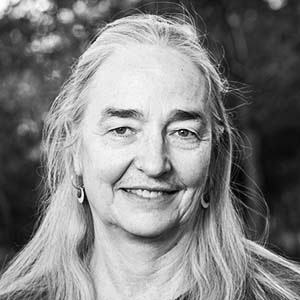Citation

Prof. Suzanne Anderson works on (and defines) the interface between geomorphology, hydrology, and geochemistry; her creative and novel scholarship and strong leadership in the critical zone community have vastly expanded and enriched surface processes research and inspired colleagues and students to tackle interdisciplinary topics.
As a graduate student, I fondly remember immersing myself in Suzanne’s papers; the margins of my hard copies were littered with comments, questions, and sketches…evidence of the inspiration she continues to impart.
Dr. Anderson cowrote the textbook through which our students learn geomorphology, and my students have been fortunate to stand atop hillslopes where Suzanne used fundamental observations, experiments, and models to characterize how rock is transformed in the near-surface environment. She deftly weaves together concepts and processes like rock fracturing, chemical weathering, soil production, and hydrologic response to make sense of the terrain.
Suzanne also takes time to write papers that synthesize our knowledge of critical zone processes. Her conceptual model of a chemical reactor on a hillslope provides an elegant and accessible framework, and her work on the geochemistry of glaciated landscapes has key implications for global solute loads and the carbon cycle.
As a central player in critical zone research, Suzanne established the Boulder Creek Critical Zone Observatory, where a limited footprint existed previously. Such work requires a ridiculous amount of time, patience, and vision, and Suzanne’s efforts led to a welcoming and inclusive platform for others to collaborate and forge discovery. With dedication and care, Suzanne’s outreach opened up the critical zone to a new and more diverse generation of scientists.
In the words of Kate Maher, “When we connect the dots back to the origins of critical zone science, Suzanne’s work is at the center.” Suzanne Anderson is supremely deserving of the G. K. Gilbert Award. Congratulations!
—Josh Roering, University of Oregon, Eugene
Response
I thank Josh Roering and the committee for their kind words and effort. I’m indebted to Bob and our daughters, Grace and Hannah, for their support and love. It’s doubly humbling to receive the G. K. Gilbert Award: Gilbert is legendary, and previous recipients are personal heroes.
Until the 2018 award to the incomparable Ellen Wohl, only white men had received the Gilbert Award. In 2019, awardee Kelin Whipple urged us to focus on increasing diversity. This year, explosion of the Black Lives Matter movement has heightened awareness of racism and of barriers to persons of color. Our commitment to inclusiveness must redouble.
Commitment is easy; it’s harder to find effective ways to build an inclusive community. From personal experience, some simple actions can make a difference.
Be an example. My mother attended community college when I was in junior high school. Botany class inspired her lifelong volunteer work documenting and cataloging plant specimens, using her homemade plant press and her microscope. She followed her interests, an example that freed me to beat my own drum.
Inspire, encourage, and validate. Exploring geology, I found inspiration in the geomorphology class cotaught by Tom Dunne and Bernard Hallet. As my M.S. adviser, Bernard listened to my nascent ideas and validated my timid steps. At a social event, Tom explicitly encouraged me to pursue a Ph.D. These actions matter.
Foster community. Myriad surface processes grad students formed a community that nurtured my sense of belonging. Bill Dietrich modeled inclusivity with a diverse and gender-balanced group of students and visitors.
We all have the power to set an example, to encourage, to listen, to validate, and to build community. I urge all to use your powers—your superpowers—to build our surface processes community into one that is diverse and welcoming.
—Suzanne Anderson, University of Colorado Boulder
Citation:
(2021), Anderson receives 2020 G. K. Gilbert Award in Surface Processes, Eos, 102, https://doi.org/10.1029/2021EO160195. Published on 01 July 2021.
Text © 2021. AGU. CC BY-NC-ND 3.0
Except where otherwise noted, images are subject to copyright. Any reuse without express permission from the copyright owner is prohibited.
